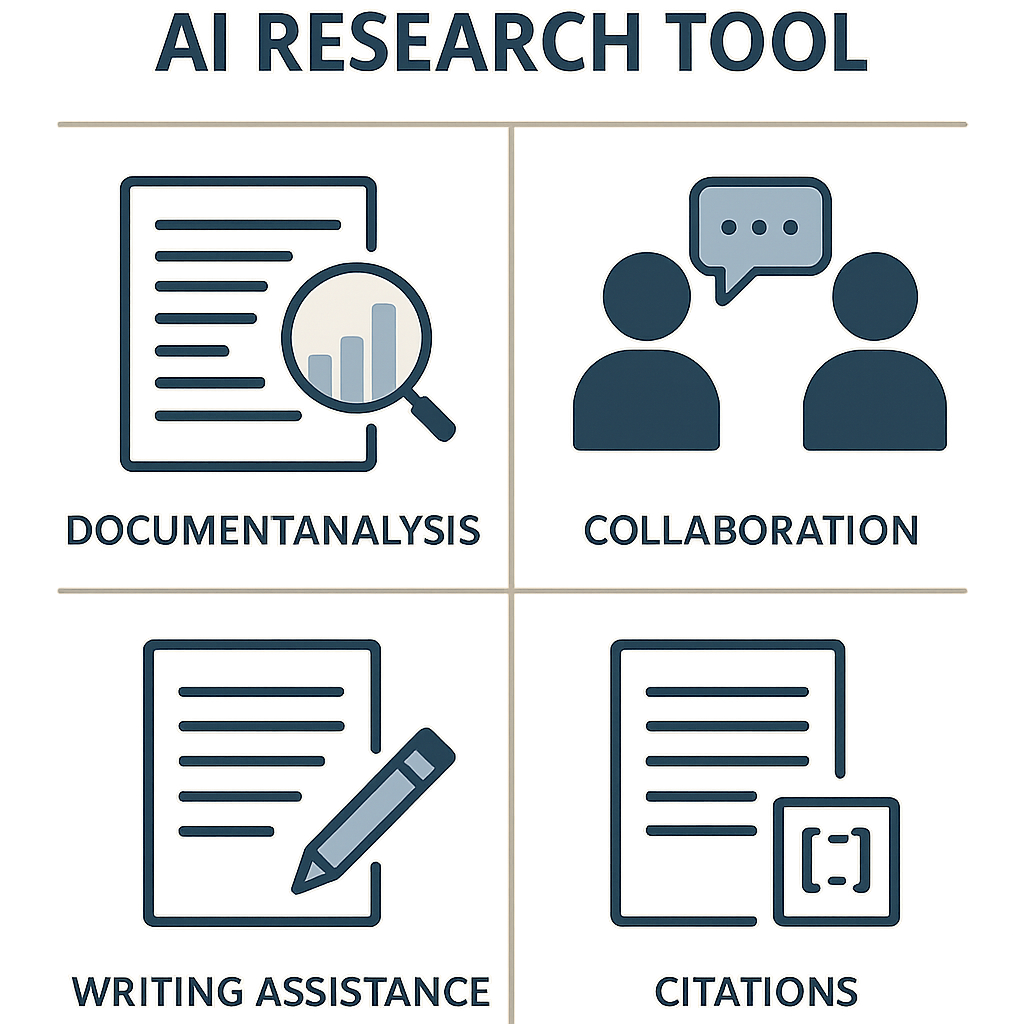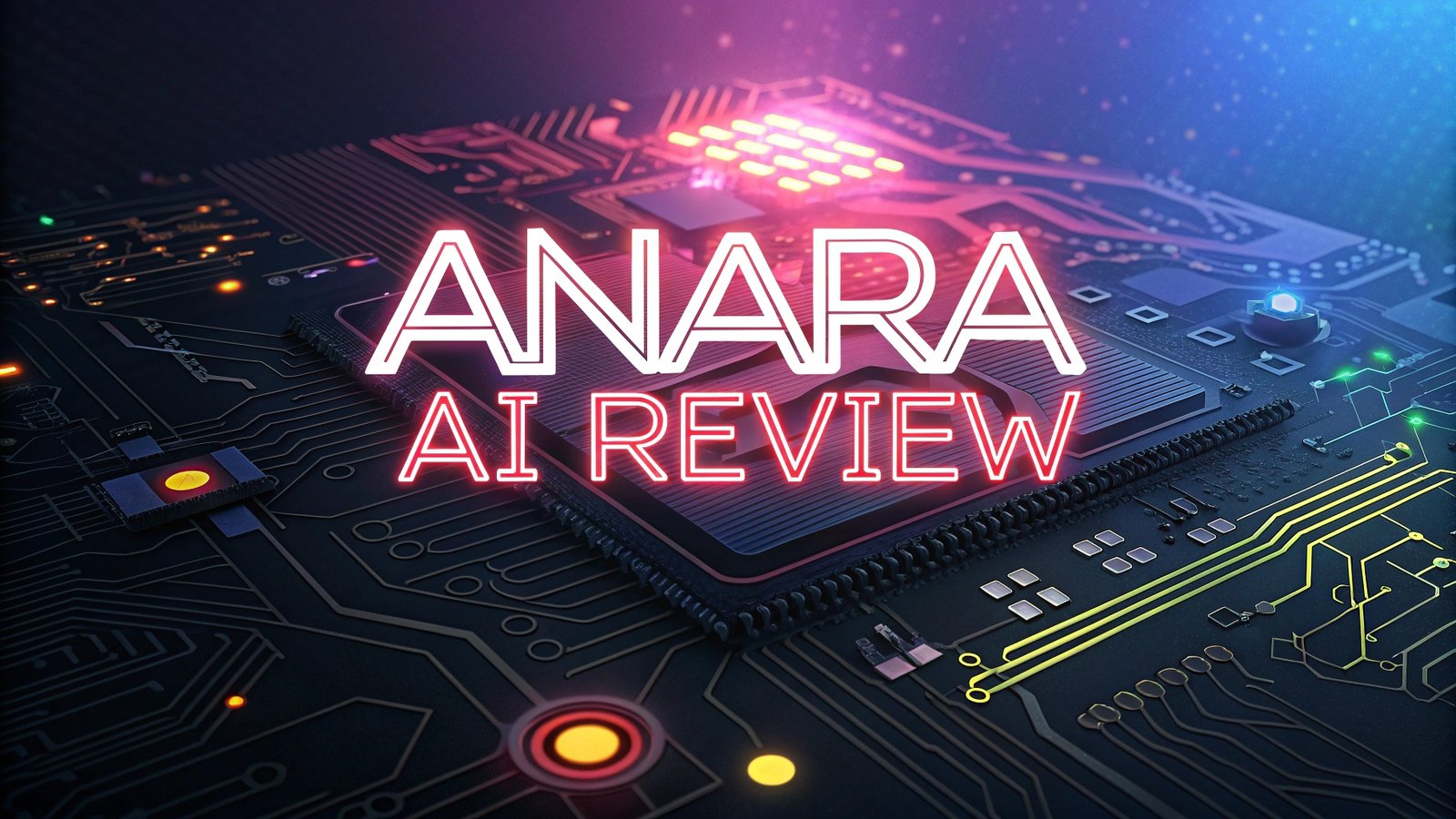Anara AI Review 2025: Revolutionary AI Research Assistant
The academic research landscape has changed dramatically in 2025. Students and researchers face an overwhelming amount of information daily.
Finding relevant papers, understanding complex concepts, and writing quality research has become more challenging than ever.
Anara AI emerges as a game-changing solution that promises to revolutionize how we approach academic research and writing.

Key Takeaways:
- Massive user adoption: Over 3 million researchers worldwide trust this platform, including teams at prestigious institutions like Johns Hopkins, Stanford University, and Roche Pharmaceutical
- All-in-one research solution: Anara AI combines document analysis, AI writing assistance, citation management, and team collaboration in a single platform, eliminating the need for multiple tools
- Advanced AI models: Access to premium AI models including GPT-4.1, Claude 3.5, and Gemini 2.5 Pro ensures accurate and comprehensive research assistance
- Flexible pricing options: Three distinct plans cater to different needs, from a generous free plan for beginners to comprehensive team solutions for research groups
- Multimedia processing capabilities: Unlike basic AI tools, this platform processes PDFs, audio files, videos, handwritten notes, and even scanned documents with equal efficiency
- Source verification focus: Every AI-generated response includes direct source citations and highlighting, ensuring academic integrity and reducing the risk of misinformation
Anara AI has achieved remarkable growth in just 18 months, reaching over 3 million users and $2.5M annual revenue
What is Anara AI and How Does It Work
Anara AI, formerly known as Unriddle, represents a significant advancement in academic research technology. This Y Combinator-backed platform serves as an intelligent research assistant that helps users understand complex academic materials, organize findings, and produce well-cited documents.
The platform operates through a simple yet powerful process. Users upload their research materials, whether PDFs, audio recordings, or video lectures. The AI then analyzes these documents and creates a comprehensive understanding of the content. This analysis goes beyond simple text extraction – the system identifies key concepts, methodologies, research gaps, and connections between different sources.
What sets this tool apart from general AI assistants is its focus on academic integrity and source verification. Every response generated by the AI includes specific citations that link directly to the original source material. Users can click on any citation to view the exact passage where the information originated. This feature addresses one of the biggest concerns in academic research – ensuring that AI-generated insights remain traceable and verifiable.
The platform supports multiple file formats including PDFs, Word documents, PowerPoint presentations, images, audio files, and video content. Advanced OCR technology enables the system to process handwritten notes and poorly formatted documents. This comprehensive format support makes it particularly valuable for researchers working with diverse source materials.
The user interface emphasizes simplicity and efficiency. Researchers can ask questions in natural language and receive detailed, referenced responses within seconds. The system maintains context across conversations, allowing for follow-up questions and deeper exploration of topics.
Key Features That Make Anara AI Stand Out
Anara AI offers a comprehensive suite of features specifically designed for academic and professional research. The document understanding capability forms the foundation of the platform. Users can upload research papers, books, lecture recordings, or any academic material and immediately begin extracting insights through conversational AI.
The Collections feature allows researchers to group related documents together, creating focused research environments. This proves particularly valuable for literature reviews where researchers need to compare findings across multiple studies. The AI can answer questions that span across all documents in a collection, identifying patterns and contradictions that might take hours to discover manually.
Real-time collaborative editing transforms how research teams work together. Multiple team members can simultaneously work on documents, share insights, and contribute to research projects. The platform maintains version control and allows team leaders to manage permissions and access levels.
The AI writing assistant goes beyond basic grammar checking. It provides contextual suggestions based on the research materials in your library, helps overcome writer’s block with intelligent auto-complete, and suggests relevant citations from your uploaded sources. This feature significantly reduces the time spent switching between research and writing tasks.
Advanced search capabilities enable users to find information across their entire research library instantly. Instead of manually searching through dozens of papers, researchers can ask specific questions and receive answers drawn from all their sources. The graph visualization feature creates interactive maps showing connections between ideas, authors, and concepts across research materials.

Anara AI key features infographic highlighting core capabilities
Anara AI Pricing Plans and Value Analysis
Anara AI offers three distinct pricing tiers designed to accommodate different research needs and budgets. The Free Plan provides substantial value for individual researchers and students just getting started with AI-assisted research.
The Free Plan includes 1,000 AI words per day, which typically translates to several detailed research questions and comprehensive responses. Users can upload 5 documents daily and record 1 audio file, with each upload limited to 120 pages or 20MB. This generous free tier allows users to thoroughly evaluate the platform before committing to a paid subscription.
The Pro Plan at $20 monthly removes all limitations on usage. Subscribers gain unlimited AI words, uploads, and recordings, with increased file size limits of 10,000 pages or 300MB per upload. Most importantly, Pro users access premium AI models including GPT-4.1, Claude 3.5, and Gemini 2.5 Pro, which provide more accurate and nuanced research assistance. Priority customer support ensures faster resolution of any technical issues.
The Team Plan costs $30 per seat monthly and includes everything in the Pro Plan plus collaborative features. Teams gain access to shared workspaces, real-time collaborative editing, admin panels for managing team members, and dedicated account management. For research groups and academic departments, this plan offers significant value by centralizing research workflows and enabling seamless collaboration.
When compared to hiring research assistants or purchasing multiple specialized tools, these pricing plans represent excellent value. The platform replaces several traditionally separate tools including reference managers, PDF annotators, writing assistants, and collaboration platforms.
Document Understanding Capabilities
The document analysis engine represents one of Anara AI‘s most impressive technical achievements. The system processes various document types with remarkable accuracy and depth. PDF analysis goes far beyond simple text extraction – the AI understands document structure, identifies key sections, and recognizes the relationships between different parts of academic papers.
Audio and video processing capabilities set this platform apart from competitors. Users can upload lecture recordings, conference presentations, or interview files. The system transcribes the content and creates searchable, interactive documents. Researchers can ask questions about specific topics discussed in hours of recorded content and receive precise answers with timestamps indicating where the information appears.
The handwriting recognition technology proves particularly valuable for researchers working with historical documents, field notes, or scanned materials. The system accurately converts handwritten text to digital format while maintaining the ability to reference original sources. This feature bridges the gap between traditional research methods and modern AI assistance.
Complex academic documents often contain charts, graphs, and technical diagrams. The platform analyzes these visual elements and incorporates their information into its understanding of the document. Users can ask questions about data trends, experimental results, or methodological approaches depicted in figures and receive accurate responses.
The system maintains awareness of document context and academic conventions. It recognizes citation formats, understands research methodologies, and identifies key academic concepts. This contextual understanding enables more sophisticated analysis compared to general-purpose AI tools that lack academic training.
AI Writing Assistant and Content Creation
The writing assistance features of Anara AI address common challenges faced by academic writers. The intelligent auto-complete function analyzes your existing text and research materials to suggest contextually relevant completions. This feature proves particularly valuable for overcoming writer’s block and maintaining writing momentum during long research sessions.
Citation discovery and management streamlines one of the most time-consuming aspects of academic writing. As users write, the system automatically suggests relevant papers from their research library that support their arguments. Citations are generated in multiple academic formats including APA, MLA, Chicago, and IEEE styles. The system ensures that every citation links to actual source material in the user’s library, preventing the inclusion of fabricated references.
The paraphrasing and summarization tools help researchers present information in their own voice while maintaining academic standards. These features analyze the writing style and academic level of the document to provide appropriate suggestions. Advanced tone correction ensures that writing maintains appropriate academic formality while remaining clear and engaging.
The integrated text editor provides a distraction-free writing environment with all research materials easily accessible. Writers can reference their uploaded sources without leaving the writing interface, significantly improving workflow efficiency. The editor includes version control, collaborative editing capabilities, and export options for various document formats.
AI-powered research question generation helps researchers identify potential areas for investigation. The system analyzes existing literature and suggests unexplored angles or research gaps that could form the basis for new studies. This feature proves particularly valuable for graduate students developing thesis topics or researchers seeking novel research directions.
Collaboration Features for Research Teams
Research collaboration receives significant attention in Anara AI‘s design philosophy. The shared workspace functionality creates centralized environments where team members can access common research materials, share insights, and collaborate on documents simultaneously. Team leaders maintain control over access permissions and can manage who sees which documents or projects.
Real-time collaborative editing enables multiple researchers to work on the same document simultaneously. The system tracks changes, maintains version history, and prevents conflicts when multiple users edit the same sections. Comments and suggestions can be added directly to documents, creating a comprehensive feedback system that maintains academic rigor.
The admin panel provides team leaders with oversight capabilities including user management, usage analytics, and project organization tools. These administrative features ensure that research teams can scale their use of the platform while maintaining appropriate oversight and organization.
Dedicated account management for Team Plan subscribers ensures that research groups receive personalized support. Account managers help optimize workflows, provide training for new team members, and ensure that teams maximize their return on investment. This level of support proves particularly valuable for large research institutions implementing the platform across multiple departments.
Integration capabilities allow teams to connect Anara AI with existing research workflows. The platform supports export to popular reference managers including Zotero and Mendeley, ensuring that existing research libraries can be seamlessly integrated. This integration capability reduces the friction of adopting new research tools and helps teams maintain their established workflows while gaining AI assistance.
Anara AI vs Competitors Comparison
The AI research assistant market includes several notable competitors, each with distinct strengths and limitations. SciSpace focuses primarily on academic paper discovery and basic summarization but lacks the comprehensive writing assistance and collaboration features found in Anara AI. While SciSpace offers strong literature search capabilities, it cannot process multimedia content or provide the depth of document analysis available in Anara.
Elicit excels at systematic literature reviews and paper discovery but operates primarily as a search and summarization tool. It cannot process uploaded documents from users’ personal libraries, limiting its usefulness for researchers working with proprietary or specialized materials. Elicit lacks the writing assistance and collaboration features that make Anara AI a comprehensive research solution.
ChatPDF provides basic PDF interaction capabilities but offers limited academic features. It cannot handle multimedia content, lacks citation management, and provides no collaboration tools. The platform also struggles with complex academic documents that contain technical language and specialized terminology.
Research Rabbit and Connected Papers focus on visualizing citation networks and paper relationships but provide no analysis or writing assistance. These tools complement rather than compete with comprehensive platforms like Anara AI.
What distinguishes Anara AI is its integration of multiple research workflows into a single platform. While competitors excel in specific areas, none provides the comprehensive feature set that addresses the complete research lifecycle from initial document analysis through collaborative writing and citation management.
Real User Reviews and Testimonials
User feedback reveals consistently positive experiences across different academic disciplines and career stages. PhD students particularly appreciate the platform’s ability to accelerate literature review processes that traditionally consume months of manual work. Many report completing comprehensive literature reviews in weeks rather than months.
Research scientists praise the source verification features that ensure academic integrity while leveraging AI assistance. The ability to trace every AI-generated insight back to original source material addresses concerns about AI hallucination in academic contexts. Users report increased confidence in their research quality when using the platform.
Medical professionals and healthcare researchers highlight the platform’s ability to process complex technical documents and maintain accuracy with specialized terminology. The multimedia processing capabilities prove particularly valuable for analyzing clinical presentations and research conferences.
Corporate research teams emphasize the collaboration features and administrative controls that enable large-scale implementation. Team leaders report significant productivity improvements when research groups adopt the platform organization-wide. The ability to maintain oversight while enabling individual productivity proves crucial for institutional adoption.
International researchers appreciate the platform’s multilingual support and ability to process documents in various languages. This global accessibility enables research collaboration across linguistic boundaries and expands access to international literature.
Some users note initial learning curves associated with maximizing the platform’s advanced features. However, most report that the productivity gains justify the initial time investment required to master the system.
Best Use Cases for Students and Researchers
Graduate students conducting thesis research represent an ideal use case for Anara AI. The platform accelerates literature review processes while ensuring comprehensive coverage of relevant sources. Students can upload dozens of papers and quickly identify common themes, research gaps, and methodological approaches across their entire corpus of sources.
Systematic review researchers benefit significantly from the platform’s ability to analyze large numbers of papers simultaneously. The system can identify patterns, extract data points, and compare methodologies across multiple studies, tasks that traditionally require extensive manual effort. The source verification features ensure that systematic reviews maintain the rigorous standards required by academic journals.
Interdisciplinary researchers working across multiple fields find particular value in the platform’s ability to bridge different academic vocabularies and research traditions. The AI can identify connections between concepts from different disciplines that might not be apparent to researchers focused on a single field.
Corporate research and development teams use the platform to stay current with academic literature relevant to their industry. The ability to process both academic papers and internal corporate documents creates comprehensive knowledge bases that inform strategic decision-making.
Undergraduate students learning research skills benefit from the platform’s educational features. The AI provides explanations of complex concepts, helps students understand research methodologies, and guides them through the process of academic writing. The citation assistance features help students learn proper academic attribution while building their research skills.
Professional researchers managing multiple concurrent projects appreciate the organizational capabilities that keep different research streams separate while enabling cross-project insights when relevant.
Pros and Cons of Using Anara AI
Advantages of Anara AI include significant time savings in research workflows. Users consistently report completing tasks in 30 minutes that previously required 3 hours. The comprehensive feature set eliminates the need for multiple specialized tools, reducing software costs and learning overhead.
The source verification system addresses major concerns about AI accuracy in academic contexts. Every response includes direct links to source material, enabling users to verify information quickly. This transparency builds confidence in AI-assisted research among traditionally skeptical academic communities.
Multimedia processing capabilities provide competitive advantages over platforms that only handle text documents. Researchers can analyze lecture recordings, conference presentations, and other audio-visual materials alongside traditional academic papers.
The collaborative features enable research teams to work more efficiently while maintaining quality control. Real-time editing and shared workspaces eliminate common collaboration friction points.
Limitations include the learning curve required to maximize advanced features. New users may initially struggle to understand the full range of capabilities available. Audio transcription accuracy can diminish in environments with background noise or poor recording quality.
The free plan restrictions may limit heavy users who quickly exceed daily quotas. While generous compared to competitors, active researchers may find the limitations constraining.
Some users report occasional processing delays with very large documents or when the platform experiences high usage volumes. While generally reliable, these intermittent issues can disrupt research workflows.
Getting Started with Anara AI
Beginning with Anara AI requires no technical expertise or complex setup procedures. New users can create accounts and begin analyzing documents within minutes of registration. The free plan provides immediate access to core features without requiring payment information.
Initial setup involves uploading a few representative documents from your research area. The platform performs better when provided with a foundation of relevant materials that establish context for your research interests. Starting with 5-10 key papers in your field provides the AI with sufficient background to generate meaningful insights.
Exploring the interface through guided tutorials helps new users understand available features. The platform includes interactive walkthroughs that demonstrate document analysis, question asking, and writing assistance capabilities. Taking time to complete these tutorials significantly improves long-term productivity with the platform.
Organizing research materials into Collections creates focused research environments. Grouping papers by project, topic, or methodology enables more targeted analysis and reduces information overload. The platform works more effectively when research materials are thoughtfully organized rather than uploaded randomly.
Experimenting with different question types helps users understand the AI’s capabilities and limitations. Starting with basic factual questions and gradually progressing to complex analytical queries builds familiarity with the system’s responses.
Integration with existing workflows requires planning how Anara AI fits into current research processes. The platform works best when incorporated into daily research routines rather than used sporadically for specific projects.
FAQs
How does Anara AI ensure accuracy and prevent hallucinations?
Anara AI addresses accuracy concerns through its source-based response system. Unlike general AI tools that generate responses from training data, this platform only provides information directly extracted from uploaded documents. Every response includes specific citations that link to exact passages in source materials.
The source highlighting feature shows users precisely where information originates within their documents. When the AI makes a claim or provides data, users can immediately verify the information by clicking on citation links. This transparency enables researchers to maintain academic integrity while benefiting from AI assistance.
Can Anara AI replace human researchers and critical thinking?
Anara AI functions as an intelligent research assistant rather than a replacement for human expertise. The platform excels at processing large volumes of information quickly and identifying relevant passages, but it cannot replace the critical analysis and creative thinking that characterizes high-quality research.
Human judgment remains essential for interpreting findings, evaluating research quality, and developing novel insights. The AI helps researchers process information more efficiently but cannot determine which research questions are worth pursuing or how findings should be interpreted within broader contexts.
What file formats and document types does Anara AI support?
Anara AI processes an extensive range of file formats to accommodate diverse research materials. PDF documents receive the most sophisticated analysis, with the system extracting text, understanding document structure, and analyzing charts and figures within academic papers.
Audio and video files undergo transcription and analysis, creating searchable documents from recorded content. The platform supports common formats including MP3, WAV, MP4, and other multimedia files. Researchers can analyze lecture recordings, interviews, conference presentations, and other audio-visual materials.
Image processing capabilities include analysis of scanned documents, photographs of handwritten notes, and technical diagrams. Advanced OCR technology converts visual text into searchable content while maintaining references to original sources.
How does the collaboration feature work for research teams?
Team workspaces in Anara AI create shared environments where multiple researchers can access common documents and collaborate on projects. Team administrators control access permissions and can determine which team members see specific documents or collections.
Real-time collaborative editing enables simultaneous work on documents without version conflicts. The system tracks changes made by different users and maintains comprehensive edit histories. Comments and suggestions can be added directly to documents, creating threaded discussions about specific content.
Shared collections allow teams to organize research materials collaboratively. Team members can contribute documents to shared collections and benefit from collective analysis. The AI draws insights from the entire team’s research library when answering questions, leveraging the group’s comprehensive knowledge base.

I’m Liza, the founder and author of Liza AI Blog, where I share my passion for artificial intelligence through insightful guides and updates. I’m dedicated to making AI accessible to everyone, and I strive to create a community that’s both informed and engaged. Through my blog, I aim to promote a deeper understanding and appreciation of AI and its potential to shape our future. You can reach me at lizaaiblog@gmail.com or follow me on social media to stay updated on the latest AI news and trends.







